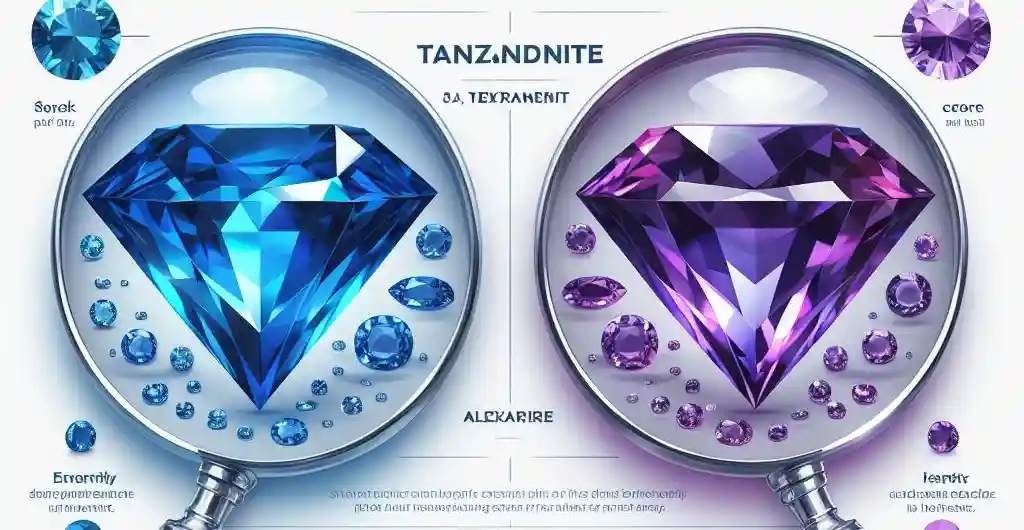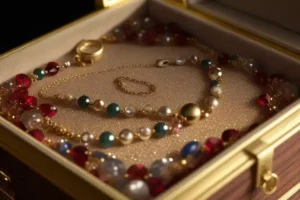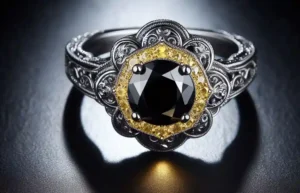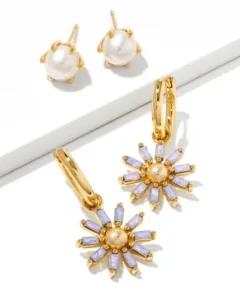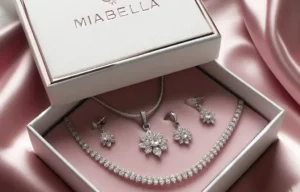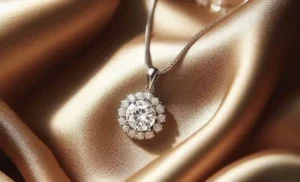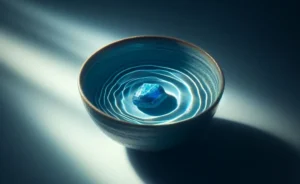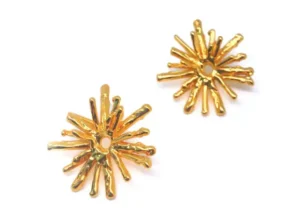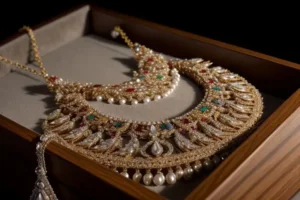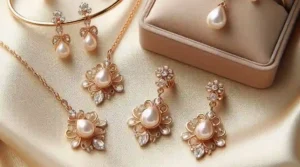Tanzanite vs Alexandrite: In the realm of precious gemstones, both tanzanite and alexandrite hold a mystique that captivates jewelry lovers worldwide.
Whether you’re considering an investment in a piece of jewelry or simply enchanted by their beauty, understanding the nuances of tanzanite and alexandrite is essential.
This guide delves into their origins, visual appeal, durability, value, and more to help you make an informed choice.
The Allure and Origins of Tanzanite and Alexandrite
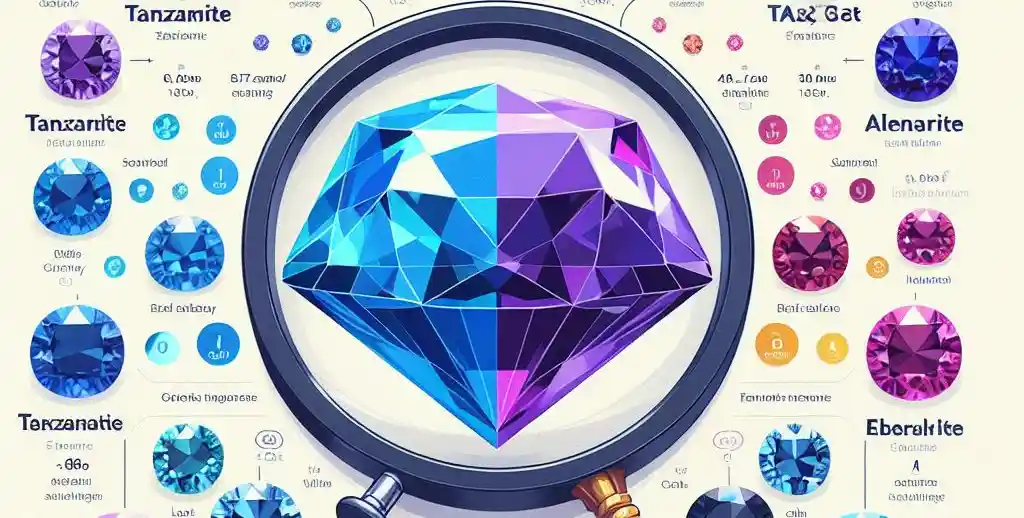
Nestled within the rich tapestry of gemstone lore, tanzanite and alexandrite emerge as two jewels with enchanting backstories and unique geographic roots.
Discovered in the shadow of Mount Kilimanjaro in 1967, tanzanite’s vibrant blues and violets capture the essence of its sole source, Tanzania, making it not just a gem but a geographic marvel. This single-source exclusivity lends tanzanite a charm that is as profound as its hue, symbolizing a rare treasure of the earth.
Conversely, alexandrite’s journey began in the 19th century within the cold embrace of Russia’s Ural Mountains, named in honor of Tsar Alexander II. Its discovery predates that of tanzanite, embedding it deeper into the annals of gemstone history.
What makes alexandrite particularly fascinating is its chameleon-like quality—its ability to exhibit a dramatic shift in color from lush green in daylight to deep reddish-purple under incandescent light. This remarkable feature not only highlights the gemstone’s dual personality but also its rarity and the mystique surrounding its origins.
As the narrative of these gemstones unfolds, their origins are more than just a point on the map; they are a testament to the Earth’s ability to conceal wonders in its crust, only revealing them to add sparkle to our lives.
Tanzanite and alexandrite stand as beacons of natural beauty, each with a story that intertwines the allure of discovery with the charisma of the unknown.
Tanzanite vs Alexandrite – Color and Appearance
Tanzanite enchants with its deep, saturated tones ranging from a mesmerizing blue to an alluring violet. This distinctive color palette not only sets tanzanite apart but also embodies the gemstone’s inherent pleochroism, allowing it to exhibit various colors when observed from different angles.
This characteristic adds a layer of depth and intrigue to tanzanite, enhancing its visual appeal and making it a focal point of fascination in any jewelry piece.
Alexandrite, on the other hand, presents a visual marvel unmatched by many other gemstones. Its hallmark is the dramatic shift in color it undergoes under different lighting conditions. In the daylight, alexandrite displays a captivating green, seamlessly transitioning to a rich reddish-purple in incandescent light.
This chameleon-like quality not only makes each alexandrite piece uniquely mesmerizing but also adds a dynamic element to jewelry that captures the imagination and admires alike.
Both gemstones offer a visual splendor that speaks to the soul, each with its unique allure. Tanzanite’s captivating hues evoke the depths of the ocean and the expanse of the twilight sky, while alexandrite’s shifting colors celebrate the gemstone’s multifaceted nature and the magic of light.
Their appearance goes beyond mere beauty, embodying the wonder of nature’s artistry and the meticulous craftsmanship that brings out their best features in jewelry.
Durability and Care – What You Need to Know
Navigating the intricacies of gemstone durability is crucial for jewelry aficionados, particularly when comparing tanzanite and alexandrite. With a Mohs hardness scale rating of 6.5 to 7, tanzanite presents a softer profile. Its exquisite beauty demands mindfulness to avert potential damage such as scratches or chips.
This characteristic underscores the importance of designated storage and gentle wear, particularly avoiding exposure to harsh activities that could compromise its integrity.
In contrast, alexandrite boasts a more robust constitution with a hardness rating of 8.5 on the Mohs scale, endorsing it as a gem fit for the rigors of daily wear. Its resilience to scratches and lesser susceptibility to damage makes it a practical choice for pieces intended for frequent use.
However, regardless of hardness, both stones benefit from preventive measures to sustain their luster and structural integrity over time.
The approach to care for each of these gemstones mirrors their durability. Tanzanite, with its delicate nature, necessitates avoidance of extreme temperatures, harsh chemicals, and physical knocks. Cleaning with mild soap and lukewarm water, followed by a gentle pat dry, is advisable.
Alexandrite, while sturdier, also thrives with similar gentle cleaning techniques, ensuring its captivating color change phenomenon remains unhindered by the accumulation of residues.
Adhering to these guidelines not only preserves the physical allure of tanzanite and alexandrite but also prolongs their lifespan, allowing their enchanting beauty to be cherished for generations.
Rarity and Value – Investing in Gemstones
The allure of investing in gemstones such as tanzanite and alexandrite lies not only in their beauty but also in their scarcity and market value.
Tanzanite, exclusively found within the shadows of Tanzania, offers a somewhat more accessible entry point into the world of rare gemstones due to its relatively more abundant supply compared to alexandrite. This accessibility translates to a generally lower price point, making it an attractive option for those looking to begin their collection of precious stones.
On the other hand, alexandrite stands out in the gemstone market for its profound rarity, especially specimens showcasing a pronounced color shift from green to reddish-purple. This scarcity significantly elevates its value, rendering alexandrite a coveted gem among collectors and investors alike.
The market for alexandrite can command high prices, particularly for stones that exhibit a dramatic color change, paired with clarity and a favorable cut.
Their rarity influences the investment potential of both tanzanite and alexandrite, but it is alexandrite’s exceptional characteristics that often place it at a higher value bracket.
While the upfront cost of acquiring alexandrite may be greater, its rarity and the fascination with its color-changing properties can make it a more valuable asset over time.
Prospective investors should, however, weigh these factors against personal budget and the specific attributes they value in gemstones, as both tanzanite and alexandrite offer unique opportunities within the realm of jewelry investment.
Ethical Considerations and Sustainability
In the quest for beautiful gemstones like tanzanite and alexandrite, it’s imperative to navigate the delicate balance between acquiring these treasures and upholding ethical standards and sustainability.
The mining of tanzanite, confined to a singular geographic region in Tanzania, has brought to light significant concerns regarding the environmental footprint left by extraction processes and the well-being of local mining communities.
Initiatives aiming to foster responsible mining practices have been introduced, aiming to mitigate negative impacts and ensure fair treatment and safety for workers.
Similarly, the extraction of alexandrite, prized for its rarity and remarkable colour-changing ability, involves meticulous scrutiny to prevent detrimental effects on the environment and promote ethical labour practices in its source regions.
The scarcity of alexandrite amplifies the importance of adhering to responsible sourcing to maintain its availability for future generations without compromising the ecological and social fabric of its native landscape.
As part of a global movement towards more ethically sourced and environmentally friendly options, the gemstone industry, including stakeholders in tanzanite and alexandrite markets, is increasingly turning towards sustainable mining technologies and methods.
Additionally, lab-grown alternatives have emerged as a viable solution, offering the same aesthetic appeal with a significantly reduced environmental impact.
Consumers now have the power to influence the market towards more ethical practices by prioritizing sustainability and ethical sourcing in their purchasing decisions, contributing to a more responsible and conscious gemstone industry.
Choosing the Right Gemstone for You – Personal Style and Preferences
Making a decision between tanzanite and alexandrite is a journey that takes you beyond the mere aesthetics of these gemstones to consider how they align with your expression and lifestyle.
If the dynamic, colour-changing nature of alexandrite speaks to you, captivating your imagination with its green to reddish-purple transformation under different lights, it suggests a preference for a stone that tells a story of versatility and surprise.
Its robustness aligns with a more active lifestyle, allowing for frequent adornment without undue concern for wear and tear.
Alternatively, the allure of tanzanite, with its deep blues and violets, may resonate more with those who are drawn to the calming and profound depths of its color. This choice might reflect a penchant for the mystical and the serene, embodying a piece of the sky and ocean captured within a gemstone.
Given its more delicate nature, it may appeal to those who seek beauty in fragility, reserving its wear for moments that call for an extra touch of elegance and significance.
Each gemstone brings with it a narrative — tanzanite. This geographical exclusivity connects you to the landscapes of Tanzania and Alexandrite, a historical charm that echoes the regality of tsarist Russia. The decision, therefore, transcends physical beauty, touching upon how you see yourself reflected in the stories these stones carry and the statements they make when set into jewelry that adorns your person.
Care Tips for Tanzanite and Alexandrite Jewelry
Maintaining the pristine condition of your tanzanite and alexandrite jewelry requires a nuanced approach tailored to the individual characteristics of each gemstone. For tanzanite, with its softer composition, care must be taken to protect it from potential abrasions and impacts that could lead to scratches or more significant damage.
It’s advisable to clean tanzanite using a solution of warm water and mild soap, employing a soft brush to gently remove any accumulated debris. After cleaning, ensure it is thoroughly rinsed and dried with a soft, lint-free cloth.
Alexandrite, possessing greater durability, nonetheless benefits from cautious handling to preserve its remarkable color-changing attributes.
Similar to tanzanite, a cleaning regimen involving mild soap and warm water is recommended for alexandrite, with the addition of a soft brush to carefully cleanse the stone. Rinsing thoroughly and drying with a soft cloth will help maintain its luster.
For both types of gemstone jewelry, it is critical to avoid exposure to harsh chemicals, extreme temperatures, and rough physical activities that could jeopardize their integrity.
When not in use, storing your tanzanite and alexandrite pieces in individual soft cloth pouches or within a lined jewelry box can prevent accidental scratches and keep them in optimal condition. Adhering to these care tips will ensure that your gemstone jewelry remains a source of beauty and pride for many years to come.
The Future of Tanzanite and Alexandrite in the Jewelry World
The trajectory of tanzanite and alexandrite within the realm of jewelry is poised for an exciting evolution. As these gemstones captivate a broader audience, their inclusion in contemporary designs is set to redefine trends, marrying traditional elegance with modern appeal.
The increasing consumer knowledge about the unique attributes and stories behind each stone is fostering a deeper appreciation, potentially elevating their status and demand in the market.
Emerging trends in jewelry design that prioritize individuality and distinctiveness could see tanzanite and alexandrite becoming focal points in bespoke pieces. This shift is likely to inspire jewelers and designers to experiment with innovative settings and combinations, spotlighting these gemstones’ versatility and natural beauty.
Moreover, the growing emphasis on ethical sourcing and sustainability in the jewelry industry may spotlight lab-grown alternatives, offering consumers choices that align with their values without compromising on aesthetics.
The rising interest in tanzanite and alexandrite also hints at their promising investment potential. As these stones become more integral to high-fashion collections and sought-after by discerning collectors, their value is anticipated to climb, reflecting their rarity and the increasing preference for jewelry with a compelling narrative.
In the changing landscape of jewelry, tanzanite and alexandrite stand at the cusp of a renaissance, poised to enchant a new generation of enthusiasts with their unparalleled beauty and mystique.
FAQs
Which is rarer, tanzanite or alexandrite?
Alexandrite is rarer due to its very specific conditions required for formation, making it highly sought after by collectors.
Can tanzanite and alexandrite be worn every day?
While alexandrite, with its higher hardness rating, is more suited to daily wear, tanzanite’s softer nature means it requires a bit more care and might be better suited for special occasions.
Do these gemstones have any synthetic versions?
Yes, both tanzanite and alexandrite have lab-grown alternatives that mimic their natural beauty and offer a more ethical and environmentally friendly option.
How do I know if my gemstone is real?
Authenticity can be verified through certification from reputable gemological laboratories, which is crucial when investing in high-value gemstones like alexandrite and tanzanite.
Can the color of alexandrite and tanzanite fade over time?
Proper care is essential as harsh chemicals or extreme temperatures can affect the vibrant colors of both gemstones, though fading is not commonly reported with mindful maintenance. These insights aim to address common curiosities, guiding enthusiasts in their journey to explore the enchanting worlds of tanzanite and alexandrite.

